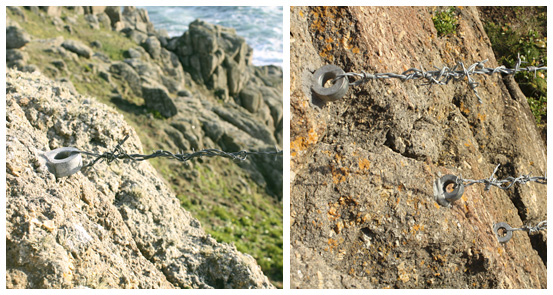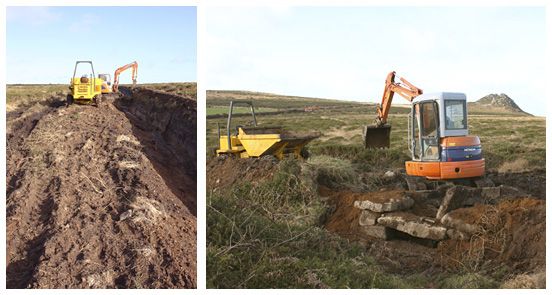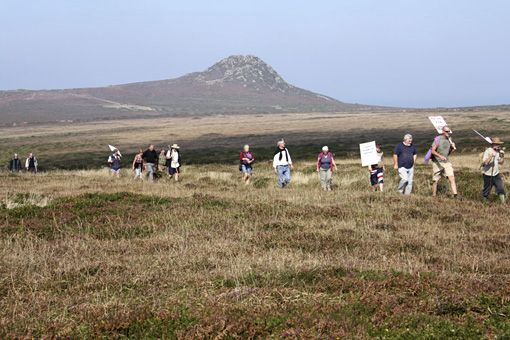Barbed Wire, Bolts and Climbers’ Club Controversy
The Climbers’ Club are pressing ahead with plans to enclose their climbing hut, the Count House at Bosigran, West Cornwall, as part of Natural England’s controversial HEATH grazing project (see report on Javu 19th September 2008). The enclosure will be made up of a 1.2 metre granite wall (known as a ‘Cornish Hedge’) at the front of the Count House with post and barbed wire fencing to the sides and rear. The work will be paid for entirely by Natural England.
Meanwhile, part of the same HEATH grazing project is raising controversy in the Chair Ladder area, because of extensive use of barbed wire fencing and bolt anchors throughout the surrounding open cliffland. At one point the fencing includes several strands of barbed wire, fixed between 16 bolts in natural granite, that extends some distance down the cliffs at Roskestal, between Chair Ladder and Carn Barra. There is growing criticism, of both the Climbers’ Club’s proposed granite wall and what is alleged as ‘grotesque’ and ‘insensitive’ use of barbed wire fencing in Areas of Outstanding Natural Beauty such as the Chair Ladder area and other parts of West Cornwall’s open moorland and cliffs.
The Climbers’ Club’s previous application for a wall in front of their property was ‘de-registered’ following an objection by Cornwall County Council’s Historic Environment Service and indications by the National Trust that they would review their grazing plans for the neighbouring Carn Galver area. The Club believes the Count House stock-proofing is necessary to prevent cattle straying onto their land. Initially no more than 20 animals will graze the surrounding 150 hectares of moorland and the number is likely to remain limited. The grazing will probably be seasonal but as yet no firm plans have been announced.
The Carn Galver grazing and stock-proofing of the Count House are part of The HEATH Project which aims to develop a management model, to guide future heathland management, which will be applicable across the North-West Europe heathland landscape. However the project has met strong opposition to its grazing infrastructure in West Cornwall. The extent of this infrastructure is made clear in the HEATH Partnership’s Autumn newsletter: “So far the project has installed over 40km of fencing, 2km of Cornish Hedging and over 90 gates in order to make sites stock proof.” Opposition group, Save Penwith Moors states that the fencing and grazing is ‘directly contrary to the ESA [Environmentally Sensitive Area] scheme.’Natural England’s HEATH Project is a partnership including farmers, landowners, the district and county councils, the National Trust (itself a large landowner), Cornwall Wildlife Trust and the Eden Project. It aims to restore and protect heathland in a way that will promote biodiversity. They say the current lack of grazing on West Penwith’s moors has caused bracken and gorse to increase and dominate more vulnerable species valued for their beauty, rarity and for supporting a wide variety of wildlife. Jon Brookes, National Trust Property Manager for West Penwith says: “We strongly believe in the importance of this project, not only for the landscape and wildlife, but for people’s enjoyment of, and access to, this precious place.” He continues: “Grazing will open up more of the landscape for people to enjoy as cattle trample the gorse and bracken.”
Payments to support the grazing will be made on a six month basis for the next ten years under the Higher Level Stewardship scheme. The cash-fund for the cattle-grazing infrastructure in Penwith alone is estimated at £650,000. The Partnership’s Autumn newsletter states one of its achievements as being the ‘purchase of over £100,000 [of] machinery for local partners to carry out heathland management works.’
The Climbers’ Club’s new application (reference number 08-1193-P), showing an amendment to set back their Cornish Hedge two metres from the highway edge, was registered by Penwith District Council during the week ending 23rd October. It has been reported that the Historic Environment Service will not repeat their previous objection and that Zennor Parish Council has recommended approval. Public funding for this wall and barbed wire fencing at the Club’s holiday property will come through The HEATH Project. Due to the tendering process they cannot yet give a figure for the cost of the work, however a standard rate for Cornish hedging of approximately £110 per metre has been suggested.
Visiting rock climbers will also notice HEATH Project stock-proofing on Roskestal Cliff between Chair Ladder and Carn Barra on Penwith’s scenic South coast. A granite wall that cuts across the maritime heathland has been enlarged and fenced on both sides with barbed wire to protect it from damage by cattle. Where this fencing extends down the cliff-slope above Pellow Zawn, just south of Fox Promontory, 16 bolts have been drilled into the natural granite outcrops to anchor barbed wire strands. One of the organisations backing this scheme is the RSPB who believe cliff-top grazing in the area is important in encouraging a resurgent Cornish Chough population. Although cattle will not graze year round, removable electric fencing has not been used as a post and barbed wire system was deemed the most ‘appropriate’. A similar scheme for the nearby cliffs at Pordenack Point was abandoned as not all landowners were willing to sign up to the grazing agreement.
One aspect of the project that concerns protesters is that fencing restricts the public’s right to roam under the Countryside and Rights of Way Act, and that access may be negatively affected when the legislation is reviewed in five years time. The land surrounding the Count House, which the Climbers’ Club plan to enclose, is designated Open Access Land. Ian McNeil Cooke, co-ordinator of Save Penwith Moors asks: “Who knows what the outcome of this project will be when it ends in ten years time? Will open-access to the public be removed once this land is ‘improved’?”
Report by Barnaby Carver.
For further background on this story see:
‘Conflicting solutions in bid to conserve moors’ by journalist Des Hannigan, published in The Western Morning News on 4th November 2008
‘Running the wilds’ by journalist Alex Pitt, published in The Guardian on 17th September 2008.
and Barnaby's javu news piece from 19th September 2008.
See also: www.theheathproject.org.uk and www.savepenwithmoors.com
CAPTIONS:
1) Fencing bolts and barbed wire on the cliffs near Carn Barra, part of a HEATH Project sponsored stock-proofing scheme.
Photographs © Barnaby Carver.2) HEATH Project works to renew a ditch and earth-bank boundary between Carn Galver and Nine Maidens Common. This measure was taken to avoid the use of barbed wire fencing on this area of open moorland. © Barnaby Carver.
3) On Sunday 21st September over 70 people took part in a ‘Protest Walk’ on Nine Maidens Common, organised by Save Penwith Moors. Following this, the Nine Maidens’ Commoners decided not to apply for permission to stock-proof the common. Mike Williams, spokesman for the commoners, said “The commoners were always against any fencing across the common. Because we had abandoned our proposals for two cattle grids on the road at Boskednan, this left us with no option but to look at an additional length of electric fencing. We felt using this much electric fencing across the common compromised our original proposals too much.” © Barnaby Carver.



